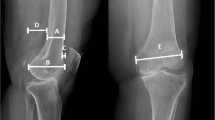Abstract
Recent modifications in total knee prosthesis design theoretically better accommodate the anatomy of the female femur and thereby have the theoretical potential to improve clinical results in TKA by more accurately restoring femoral posterior condylar offset, reducing femoral notching, reducing femoral component flexion, and reducing component overhang. First, we radiographically evaluated whether a contemporary unisex prosthesis would accommodate female anatomy equally as well as male anatomy. Next, we radiographically evaluated female knees in which a gender-specific prosthesis was used. Pre- and postoperative radiographs of 122 knees (42 female unisex, 41 male unisex, 39 female gender-specific) were reviewed. In the unisex groups, there were no differences in femoral notching or femoral component flexion. Posterior femoral offset increased in both groups. However, femoral component overhang was worse in female knees (17%) than in male knees (0%). In the gender-specific female group, the incidence of component overhang was similar to that in the unisex female group. Unisex femoral components of this specific design do not equally match the native anatomy male and female knees. In some women, a compromise was required in sizing.


Similar content being viewed by others
References
Aaron RK, Scott R. Supracondylar fracture of the femur after total knee arthroplasty. Clin Orthop Relat Res. 1987;219:136–139.
Baker PN, Van der Meulen JH, Lewsey J, Gregg PJ. The role of pain and function in determining patient satisfaction after total knee replacement. J Bone Joint Surg Br. 2007;89:893–900.
Bellemans J, Banks S, Victor J, Vandenneucker H, Moemans A. Fluoroscopic analysis of the kinematics of deep flexion in total knee arthroplasty: influence of posterior condylar offset. J Bone Joint Surg Br. 2002;84:50–53.
Booth RE. The gender specific (female) knee. Orthopedics. 2006;29:768–769.
Callaghan JJ, O’Rourke MR, Goetz DD, Schmalzried TP, Campbell PA, Johnston RC. Tibial post impingement in posterior-stabilized total knee arthroplasty. Clin Orthop Relat Res. 2002;404:83–88.
Chin KR, Dalury DF, Zurakowski D, Scott RD. Intraoperative measurements of male and female distal femurs during primary total knee arthroplasty. J Knee Surg. 2002;15:213–217.
Clarke HD, Math KR, Scuderi GR. Polyethylene post failure in posterior stabilized total knee arthroplasty. J Arthroplasty. 2004;19:652–657.
Culp RW, Schmidt RG, Hanks G, Mak A, Esterhai JL Jr, Heppenstall RB. Supracondylar fracture of the femur following prosthetic knee arthroplasty. Clin Orthop Relat Res. 1987;222:212–222.
Greene KA. Gender-specific design in total knee arthroplasty. J Arthroplasty. 2007;22(Suppl 3):27–31.
Hitt K, Shurman JR, Greene K, McCarthy J, Moskal J, Hoeman T, Mont MA. Anthropometric measurements of the human knee: correlation to the sizing of current knee arthroplasty systems. J Bone Joint Surg Am. 2003;85(Suppl 4):115–122.
Kwak DS, Surendran S, Pengatteeri YH, Park SE, Choi KN, Gopinathan P, Han SH, Han CW. Morphology of the proximal tibia to design the tibial component of total knee arthroplasty for the Korean population. Knee. 2007;14:295–300.
Polivache P, Insall JN, Scuderi GR, Font-Rodriguez DE. Rotational landmarks of the distal femur in total knee arthroplasty. Clin Orthop Relat Res. 1991;331:35–46.
Ritter MA, Harty LD, Davis KE, Meding JB, Berend ME. Predicting range of motion after total knee arthroplasty: clustering, log-regression, and regression tree analysis. J Bone Joint Surg Am. 2003;85:1278–1285.
Ritter MA, Thong AE, Keating EM, Faris PM, Meding JB, Berend ME, Pierson JL, Davis KE. The effect of femoral notching during total knee arthroplasty on the prevalence of postoperative femoral fractures and on clinical outcomes. J Bone Joint Surg Am. 2005;87:2411–2414.
Robertson O, Dunbar M, Pehrsson T, Knutson K, Lidgren L. Patient satisfaction after total knee arthroplasty: a report on 27372 knees operated on between 1981 and 1995 in Sweden. Acta Orthop Scand. 2000;71:262–267.
Vaidya SV, Ranawat CS, Aroojis A, Laud NS. Anthropometric measurements to design total knee prostheses for the Indian population. J Arthroplasty. 2000;15:79–85.
Author information
Authors and Affiliations
Corresponding author
Additional information
Each author certifies that he or she has no commercial associations (eg, consultancies, stock ownership, equity interest, patent/licensing arrangements, etc) that might pose a conflict of interest in connection with the submitted article.
Each author certifies that his or her institution has approved the human protocol for this investigation, that all investigations were conducted in conformity with ethical principles of research, and that informed consent for participation in the study was obtained.
About this article
Cite this article
Clarke, H.D., Hentz, J.G. Restoration of Femoral Anatomy in TKA With Unisex and Gender-specific Components. Clin Orthop Relat Res 466, 2711–2716 (2008). https://doi.org/10.1007/s11999-008-0454-6
Received:
Accepted:
Published:
Issue Date:
DOI: https://doi.org/10.1007/s11999-008-0454-6




